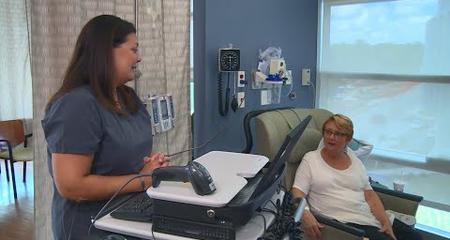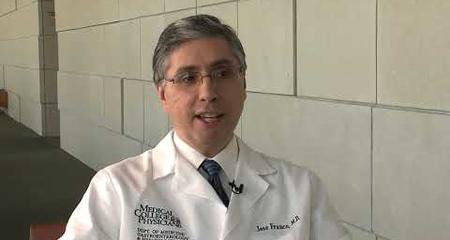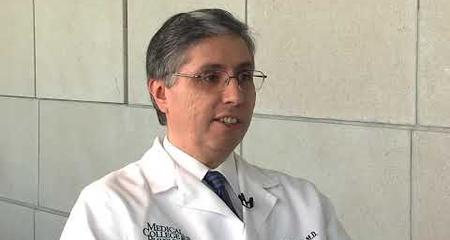Imaging — taking pictures of structures inside the body — is an important part of detecting cancer and other diseases of the liver, pancreas and bile ducts. Imaging is used to determine whether a patient is a candidate for surgery or other treatments, the stage (extent) of a person’s cancer and whether cancer has returned.
Froedtert & the Medical College of Wisconsin are at the forefront of offering the most advanced imaging technology in the country. Our ability to image disease using state-of-the-art tools means that even small tumors can be detected. Finding the precise location of disease leads to treatments that offer the best possible outcomes for patients.
Imaging for the Liver, Pancreas and Bile Ducts
Ultrasound uses high-frequency sound waves to create images of blood vessels, soft tissues and internal organs. The sound waves are bounced off tissues and organs, and their echoes produce an image called a sonogram. Ultrasound can distinguish between solid tumors and fluid-filled cysts. It can also detect if cancer has spread into blood vessels in the liver and pancreas. Ultrasound is also used to guide treatments for liver and other cancers
Intraoperative ultrasound enables surgeons to define the structure and precise location of tumors, determine the spread of cancer, and locate stones in the bile ducts or pancreas during surgery. This information can help shorten the length of an operation and increase the safety and precision of the surgery.
Magnetic resonance imaging (MRI) uses a strong magnetic field and radio frequency waves to produce detailed images of organs and structures inside the body. An MRI is used to examine the liver, pancreas and many other organs. It can assess blood flow and detect many forms of cancer.
Magnetic resonance cholangiopancreatography (MRCP) uses MRI to assess the biliary tract (bile duct, pancreatic duct and gallbladder) for tumors, stones and strictures (narrowed ducts).
CT scans (computed tomography) take cross-sectional X-ray images (“slices”) of the body. CT scans are used to diagnose cancer in the liver, pancreas and its relationship to surrounding structures (such as blood vessels) to plan and monitor response to cancer treatment.
3-D CT scans provide detailed images in three dimensions. In 2004, Froedtert & the Medical College were the first to produce patient scans using GE Healthcare’s revolutionary 64-slice volume computed tomography (VCT) scanner. Previous generations of CT scanners showed 16 or 32 pictures (“slices”) per scan; the VCT produces 64 slices in just seconds. The result is a tremendously sharp 3-D image. The VCT scanner rotates around the patient, scanning the entire body in less than 10 seconds. The images can be reconstructed in a variety of views to build a more precise diagnosis of disease.
Nuclear Medicine Imaging
Nuclear medicine imaging involves the use of a radioactive tracer (radioisotope) to diagnose, manage and treat disease. A radioisotope is a chemical element that emits radiation as it breaks down. Different tracers are attracted to tumor cells in specific organs or tissues in the body. Using special detection equipment, the radioisotope can be traced to see where it has concentrated in tumors. These scans can detect certain types of cancer, determine if cancer has spread to other areas of the body and monitor the effectiveness of cancer treatment.
Types of nuclear medicine imaging include:
- Technetium and Gallium scans — scans that involve injecting technetium or gallium (radioactive tracers) into a vein. The tracer is absorbed by organs such as the liver. The scanner detects the tracer’s location in the body and displays images on a computer. This scan is done to detect cancerous tumors, infections or areas of inflammation in the body.
- Octreotide scans — a scan used to find carcinoid tumors (slow-growing tumors) and other types of tumors. Octreotide (a radioactive drug) is injected into a vein, travels through the bloodstream and attaches to cancer cells. A device detects the octreotide and takes images showing where cancer cells are located in the body.
- PET/CT — Positron emission tomography (PET) and computerized tomography (CT) are imaging tools used to pinpoint the location of cancer within the body. The PET scan detects the metabolic activity of cancer cells, and the CT scan provides a detailed picture of the internal anatomy that reveals the location, size and shape of abnormal cancerous growths. When PET and CT scans are “fused” together, the combined image provides complete information on cancer location and metabolism.
Bloodwork and Biopsy for Liver Cancer
Your doctor will order routine blood tests including a blood count, chemistry profile, coagulation (clotting) profile, liver function tests, and alpha fetoprotein. Alpha fetoprotein may be elevated in patients with liver cancer. Additionally, your doctor may order blood tests to determine the cause of your liver disease and cancer.
On occasion, liver biopsy may be recommended if imaging tests for liver cancer are not conclusive. A liver biopsy involves removal of a small sample of liver tissue to be evaluated under the microscope by a pathologist. Liver biopsies are performed as outpatient procedures.
Virtual Visits Are Available
Safe and convenient virtual visits by video let you get the care you need via a mobile device, tablet or computer wherever you are. We’ll gather your medical records for you and get our experts’ input so we can offer treatment options without an in-person visit. To schedule a virtual visit, call 1-866-680-0505.





